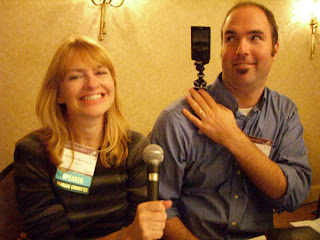Saturday I attended a couple of workshops about "New Media" ("Experiments in new media: Beautiful failures and startling successes" before lunch and "Rebooting science journalism: Adapting to the new media landscape" afterwards.) Together they convinced me that neither revolution nor evolution are the right metaphors for the impact of digital media.
A better model for what's happening in our profession is a forced migration. Old niches (like "science beat reporter" or "science writer for magazines") are drying up, so we're stampeding into new media. Not because they're better than our old watering holes in print and radio and TV, but because we have no choice. More and more of us find now that only digital media give us access to the public. Afternoon panelists Emily Bell (Columbia Journalism School) and Bora Zivkovic (new director of Scientific American's blogs) both explained the situation with rather unnerving detachment: it's no longer the case in 2010 that people can expect to make a decent living as "science journalists."
Both also said that science journalism itself would keep thriving. (Be comforted, about-to-be-extinct stegosaurus. The reptile class as a whole is secure.) How can this be? Essentially, it's because digital tools empower people to create good science journalism without getting paid. They can, like the award winning blogger Ed Yong, produce great blog posts about science in their off-hours, when they aren't at their day jobs. Or they can use social media to get once-passive readers to supply content for free. (My fellow-fellow Cori Vanchieri blogged the "beautiful failures" workshop, and provides a fine guide to many of these social-media tools in this post, so I won't reinvent that wheel. There are also good tutorials and summaries at zombie journalism, as a couple of panelists pointed out.)
For people used to traditional journalism, it's important not to be the kind of emigrant who refuses to learn the new language or otherwise adapt to a new country. We shouldn't, for example, nostalgically think of "old media" as a lost paradise. As one questioner in the afternoon workshop noted, there are plenty of over-hasty stories, misunderstood concepts and recycling of press releases in print and broadcast science journalism. (In fact, as you can read in this 2005 Economist story, the political scientist Matthew Hindman found when he compared star bloggers to star newspaper journalists, the bloggers were more likely to have an advanced degree.)
But other common migrant's error is to tell ourselves that everything about the new place is bright and beautiful and great, while the old country was awful. Yes, as the morning panel showed, social media lets us do great things we couldn't do before, like engaging the audience in real conversation. Yes, as Zivkovic said, blogs read well because they're not constrained by the conventions of old journalistic forms. Yes, this stuff is fun, and there's nothing wrong with enjoying ourselves. "There's a huge value in doing things because they're fun," said Mark Coatney, one of the morning panelists who is now the "media evangelist" for tumblr.com. Your own enjoyment is a good predictor of your audience's, he said.
Trouble is, no one knows how our new media environment will support good journalism about science. Standards of quality for online journalism don't exist (part of Bell's new job at the Tow Center at Columbia Journalism School, she said, is to create these). There are things that old-media approaches could do—supply a travel budget to research a story, support a month's worth of real research before producing a word—that we don't see in "new media" tools of science journalism.
It's easy to caricature such reservations as what's-in-it-for-me self-interest, but I don't think that's fair. Our problem as our profession migrates from the old familiar niches is that we don't really know where we're going to. We're taking part in an ongoing media experiment. And the essence of an experiment, of course, is that the experimenter doesn't know how it ends.

















